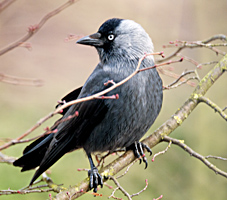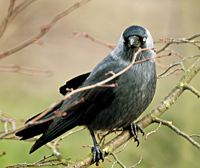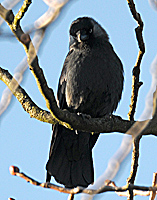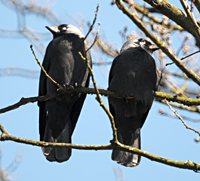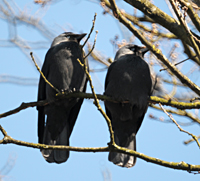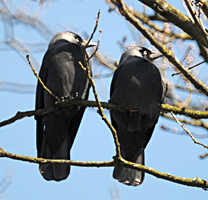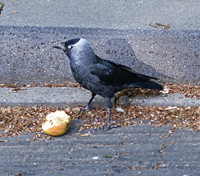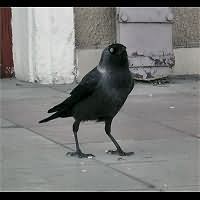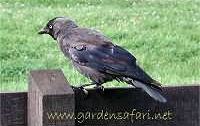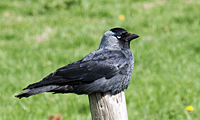[All pictures of garden wildlife on this page are thumbnails. Click on any thumbnail for a large format to be displayed.]
Jackdaw (Corvus monedula)
Click![]() here for the bird's sound.
here for the bird's sound.
When you get a chance to look at Jackdaw from close by then you see that it is a beautiful and elegant bird.
A small black member of the Jay family. Every now and then the bird appears in my back garden, though it normally remains in the bushy part of it. These are very intelligent birds. In winter they flock together and are often assisted by Rooks. In summer they normally stay on their own, although they also look for food in the open fields in small flocks. The bird is more popular than the Crow is, probably because the sounds it produces are less noisy and not so irritating.
Jackdaws relaxing in the sun.
The small and impertinent Jackdaw more and more feels at home in larger cities.
In my neighborhood farmers had a habit of picking a Jackdaw chick from a nest. They would then raise the chick by hand and soon they had a tame Jackdaw! The bird would keep the farmer company, it lived in the house. It would follow the farmer where ever he went. A tame bird would have a wild one as a partner and then it would leave the farmhouse it lived in. Thus every couple of years the farmer had to find another chick and make it tame. Jackdaws are awful thieves keen on of glittering bling-bling, just like the Magpie. When taming a Jackdaw the farmer had to really be careful not to get injured by accident. Glittery human eyes de attract attention of the Jackdaw that might attempt to steal them.
Jackdaw is very common in the country side.
Jackdaw belongs to the family of Crows (Corvidae). Although it is rather rare in my garden, it is quite common in Holland and can be seen all year round. The bird is 13" and weighs 240 grams. It lives in parks, ruines and bushy areas mostly. It eats almost everything. The sexes do not differ from one another by appearance. Jackdaws often live in small colonies. These colonies have a strict social order, a clear leader and conflicts like all societies have. Ornithologists have examined the Jackdaw's language and found out at least 8 "words"... The species breeds in may and june. It is a holebreeder that deposits four to six eggs. The breeding time is some 18 days, but the parents have to look after their young for an exceptionally long time: 30 to 35 days!
| Name of this bird in various other languages | ||||
| Dutch | German | French | Polish | Scientific |
| Kauw | Dohle | Choucas des tours | Kawka | Corvus monedula |

© Copyright 1998-2024 gardensafari.net (Hania Berdys)

 English / engels
English / engels  Dutch / nederlands
Dutch / nederlands